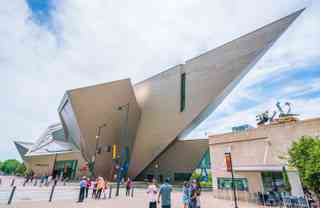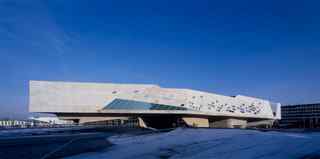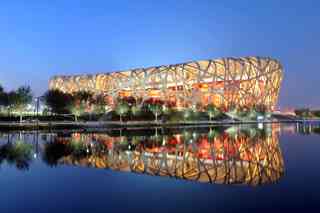It’s true that those who’ve designed our boldest buildings appear more like alchemists than they do architects. Consider your own city, or a place visited last year, and how one building defined the feel of the space more than any other. In Bilbao, Spain, for example, Frank Gehry’s Guggenheim Museum Bilbao steals the show, dwarfing all others in sight. By definition, this building, like any other, is a static object. But try explaining this to anyone who approaches the museum. On sunny days, light dances across the building’s powerful forms, while clouds, too, are absorbed into the titanium, emitting the mood of overcast days. Much of that dazzling effect is due to deconstructionism, a movement in which Gehry’s Guggenheim is a major player. What that building does so well is leap past the idea that architecture should be contained by notions of harmony or symmetry. It breaks down the archaic rules in favor of something more exciting, making titanium appear as ethereal as satin bent in the wind.
What makes deconstructionism so fascinating is that, at its core, architecture is a conservative practice. Buildings stand the test of time as a result of their stability and order. A square is a square because all of its sides are equal, ensuring stability in the greater design. But what if that square were to be distorted? Does it compromise the integrity of the structure? In fact, quite the opposite: By challenging the viewer’s perception of unity and stability, the architect can show that flaws are not only intrinsic in design but powerful and beautiful too. The most talented architects do this by placing forms in conflict with one another, competing as the building evolves into a stunning design—not unlike the powers of nature itself.
While there are many architects who have designed marvelous deconstructed structures, the seminal figures include Peter Eisenman, Bernard Tschumi, Frank Gehry, Zaha Hadid, Rem Koolhaas, and Daniel Libeskind, among others. Below, AD surveys 12 stunning buildings that have all radically changed the built environment.

Denver Art Museum, by Daniel Libeskind (Denver, Colorado)
Completed in 2006, the dynamic extension to the Denver Art Museum came courtesy of Daniel Libeskind, one of the most revolutionary architects in the world. Inspired by the surrounding Rocky Mountains, as well as the growth of Denver as a city, Libeskind’s sharp angular forms have attracted more museumgoers since they were added.

Phaeno Science Center, by Zaha Hadid (Wolfsburg, Germany)
Zaha Hadid’s iconic Phaeno Science Center is much like the natural world itself, full of mystery and discovery. Completed in 2005, the space is an interactive science center. The building, which is made of concrete and glass, stands on stilts, allowing the public to pass through. Whether the structure was meant to take the shape of a whale, or some other object, is difficult to say. What’s for certain is that the design altered Wolfburg’s built environment—so much so that a year later it was awarded the RIBA European Award.

National Stadium, by Herzog and de Meuron and Ai Weiwei (Beijing, China)
Perhaps no stadium in the world is as attenion-grabbing as Beijing’s National Stadium. Built in 2007 to host the 2008 Summer Olympics and Paralympics, the arena deconstructs the traditional notion of what a sports venue could be. Designed by Herzog and de Meuron and Ai Weiwei, the nest-like steel not only supports the structure but also has the organic feel of something created by nature itself.
The Groninger Museum, by Alessandro Mendini (Groningen, Netherlands)
The Netherlands’ Groninger Museum is like no other art museum in the world, primarily due to its irregular design. The redesign (pictured) was completed in 2011 by the Italian architect Alessandro Mendini, with other additions to the renovations coming courtesy of by Philippe Starck and Coop Himmelb(l)au. The museum made news in March, when a painting from its permanent collection by Vincent Van Gogh was stolen while on loan at the Singer Laren Museum near Amsterdam.
MAXXI, by Zaha Hadid Architects (Rome, Italy)
Completed in 2009 in Rome, Zaha Hadid’s MAXXI is the first Italian public museum devoted to contemporary arts and architecture. The building coils and turns like a snake, providing visitors moments of architectural surprise on all sides of the structure. Hadid’s design was selected in an international competition, beating out 273 competing bids. The Iraqi-born architect often used to say, “There are 359 other degrees, why limit yourself to one?” Visitors to Rome can see that creed displayed at the MAXXI.
Walt Disney Concert Hall, by Frank Gehry (Los Angeles, California)
Standing across the street from the beautiful Broad Museum by New York–based DS+R is Frank Gehry’s monumental Walt Disney Concert Hall. Located in downtown L.A. and completed in 2003, the building reflects light that appear to rise and fall, like the musical notes from any Disney soundtrack.
City of Culture of Galicia, by Peter Eisenman (Galicia, Spain)
Perhaps no form mimics the potential of deconstructed architecture than Peter Eisenman’s masterpiece, the City of Culture of Galicia. The series of buildings takes up a wide expanse that rolls in the same way a mountain range would. Visitors outside of the building are free to walk up and down the rooftop (when the incline is not too steep); while inside, visitors have an abundance of natural light from the floor-to-ceiling windows.
Seattle Public Library, by Rem Koolhaas (Seattle, Washington)
Rem Koolhaas and his team at Office of Metropolitan Architecture (OMA) certainly broke the mold when they completed the Seattle Public Library in 2004. Located in the city’s downtown, the building, with its all-glass exterior and cantilevered rooftop, stands in stark contrast to the more traditional skyscrapers in the vicinity—which is to say, it allows for pedestrians to see the power and beauty of deconstructionism in comparison to other forms of architecture.
Vitra Design Museum, by Frank Gehry (Weil am Rhein, Germany)
Completed in 1989, Frank Gehry's Vitra Design Museum was the first building in Europe designed by the Pritzker Prize–winning architect. The building, which houses a private collection of modern furniture, shows the organic growth available through deconstructionism, coupled with the curvilinear white forms as seen in Le Corbusier's iconic Notre-Dame du Haut.
Vitra Fire Station, by Zaha Hadid (Weil am Rhein, Germany)
Germany’s Vitra Fire Station was among Zaha Hadid’s first designs to be completed. Cast in concrete, the building looks like a sculpture, frozen in expression. The lack of right angles or even colors enhances the experience, allowing the viewer to take in the simplicity of each form that goes into the building as a whole.
Imperial War Museum North, by Daniel Libeskind (Manchester, England)
Deconstructing many of Daniel Libeskind’s designs is like breaking down a symphony; the many moving parts will move any critic toward appreciation. Built in 2002, and the first building in the U.K. designed by the Polish-born architect, the structure looks, at first, like a simple mash of forms. But looks can be deceiving. Libeskind’s design for the war museum serves to deconstruct the globe itself, reattaching its many parts in fractured form.
Guggenheim Museum Bilbao, by Frank Gehry (Bilbao, Spain)
Frank Gehry's revolutionary Guggenheim Museum Bilbao was such a success that a term was coined from it: the Bilbao effect , a phenomenon whereby investment in rundown areas will begin once an architectural marvel is created to attract flocks of tourists and locals alike. Completed in 1997, the daring building catches light on its many forms. What Gehry was able to do, which many other architects have tried and failed, is to making the built environment look natural, organic.
